1995 CHEVROLET CAVALIER brake light
[x] Cancel search: brake lightPage 10 of 340
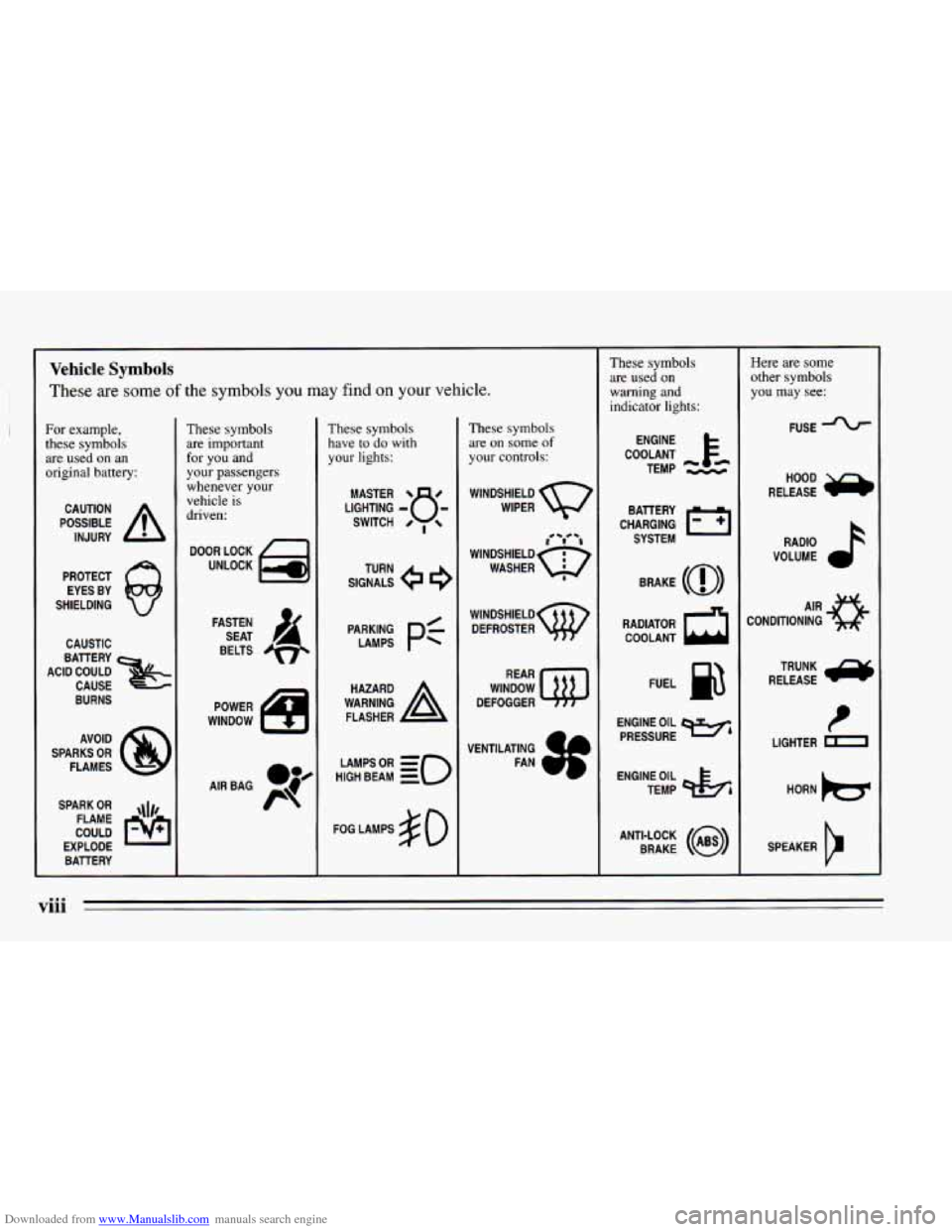
Downloaded from www.Manualslib.com manuals search engine Vehicle Symbols
These are some of the symbols you may find on your vehicle.
For example,
these symbols are used on an
original battery:
POSSIBLE A
CAUTION
INJURY
PROTECT EYES BY
SHIELDING
Q
CAUSTIC
ACID COULD BATTERY
CAUSE
BURNS
AVOID
SPARKS
OR
FLAMES
SPARK
OR ,\I/,
COULD FLAME
EXPLODE BATTERY
These symbols
are important
for you and
your passengers
whenever your
vehicle is
driven:
DOOR LOCK
UNLOCK
FASTEN SEAT
4
BELTS
POWER
WINDOW
These symbols have to
do with
your lights:
SIGNALS 6
TURN
HIGH
LAMPSoR BEAM = =o
FOG LAMPS $0
These symbols
are on
some of
your controls:
WINDSHIELD
WIPER
i i
WINDSHIELD
WASHER I
WINDSHIELD DEFROSTER
WINDOW
DEFOGGER
VENTILATING FAN
These symbols are used on
warning and
indicator lights:
COOLANT F-
ENGINE
TEMP
--
CHARGING I-1
BATTERY SYSTEM
BRAKE
(0)
RADIATOR COOLANT
a
FUEL
ENGINE OIL
PRESSURE
Wb
TEMP OIL &
ANTI-LOCK (@)
BRAKE
Here are some
other symbols
you may
see:
FUSE
RELEASE
a
RADIO
VOLUME
CONDITIONING
AIR 43
LIGHTER HORN
)b.
SPEAKER
b
viii
Page 63 of 340
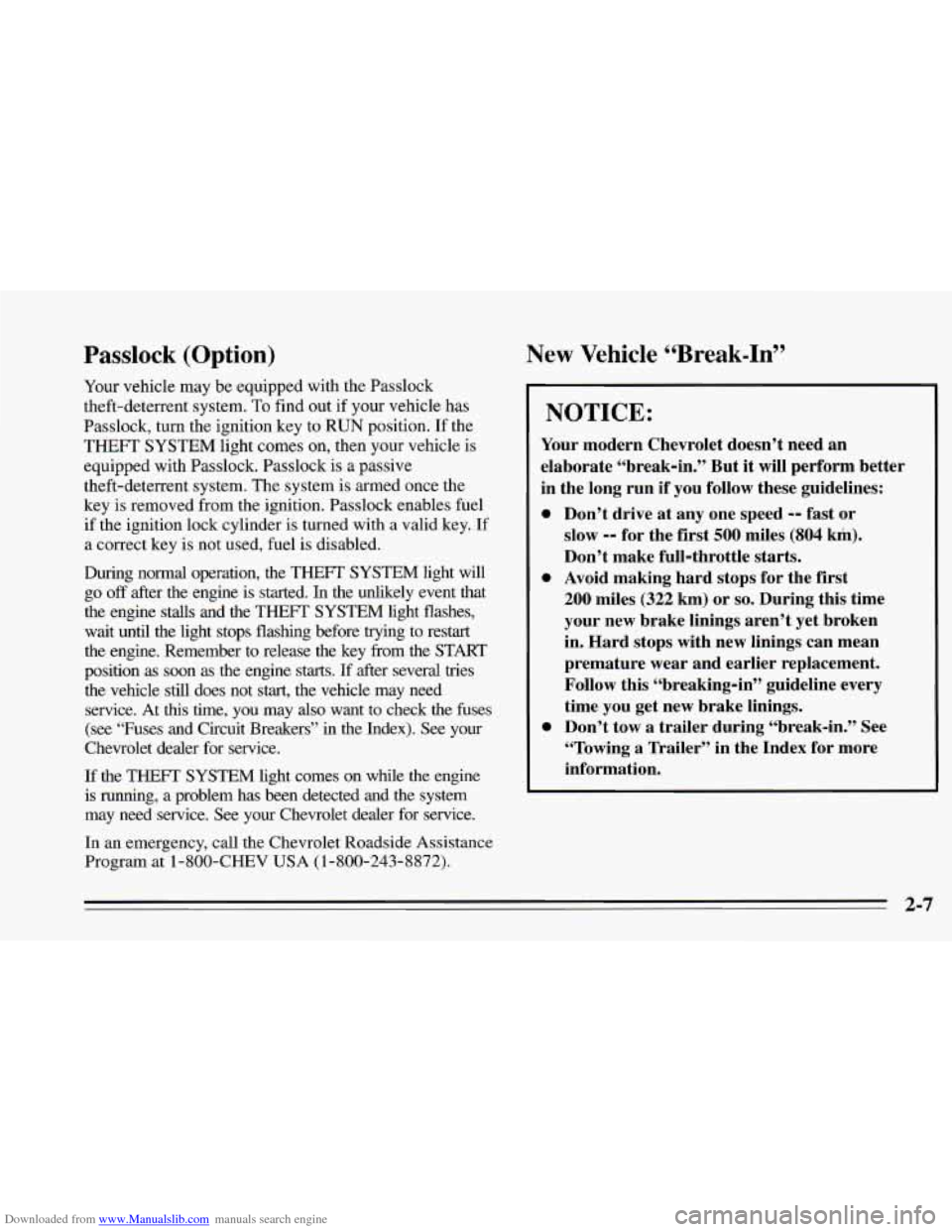
Downloaded from www.Manualslib.com manuals search engine Passlock (Option)
Your vehicle may be equipped with the Passlock
theft-deterrent system.
To find out if your vehicle has
Passlock, turn the ignition key to RUN position.
If the
THEFT SYSTEM light comes on, then your vehicle is
equipped with Passlock. Passlock
is a passive
theft-deterrent system. The system is armed once the
key is removed from the ignition. Passlock enables fuel
if the ignition lock cylinder is turned with a valid key. If
a correct key is not used, fuel is disabled.
During normal operation, the
THEFT SYSTEM light will
go
off after the engine is started. In the unlikely event that
the engine stalls and the
THEFI’ SYSTEM light flashes,
wait until the light stops flashing before
trying to restart
the engine. Remember to release the key from.the START
position
as soon as the engine starts. If after several tries
the vehicle still does not start, the vehicle may need
service. At
this the, you may also want to check the fuses
(see “Fuses and Circuit Breakers” in the Index).
See your
Chevrolet dealer for service.
If the THEFT SYSTEM light comes on while the engine
is running, a problem has been detected and
the system
may need service. See your Chevrolet dealer for service.
In an emergency, call the Chevrolet Roadside Assistance
Program at 1-800-CHEV USA (1-800-243-8872).
New Vehicle “Break-In”
Your modern Chevrolet doesn’t need an
elaborate “break-in.” But it will perform better
in the long run if you follow these guidelines:
e
e
0
Don’t drive at any one speed -- fast or
slow
-- for the first 500 miles (804 h).
Don’t make full-throttle starts.
Avoid making hard stops for the
first
200 miles (322 km) or so. During this time
your new brake linings aren’t yet broken
in. Hard stops with new linings can mean
premature wear and earlier replacement.
Follow this “breaking-in” guideline every
time you get new brake linings.
Don’t tow a trailer during “break-in.” See
“Towing a Trailer’’ in the Index for more
information.
2-7
Page 78 of 340
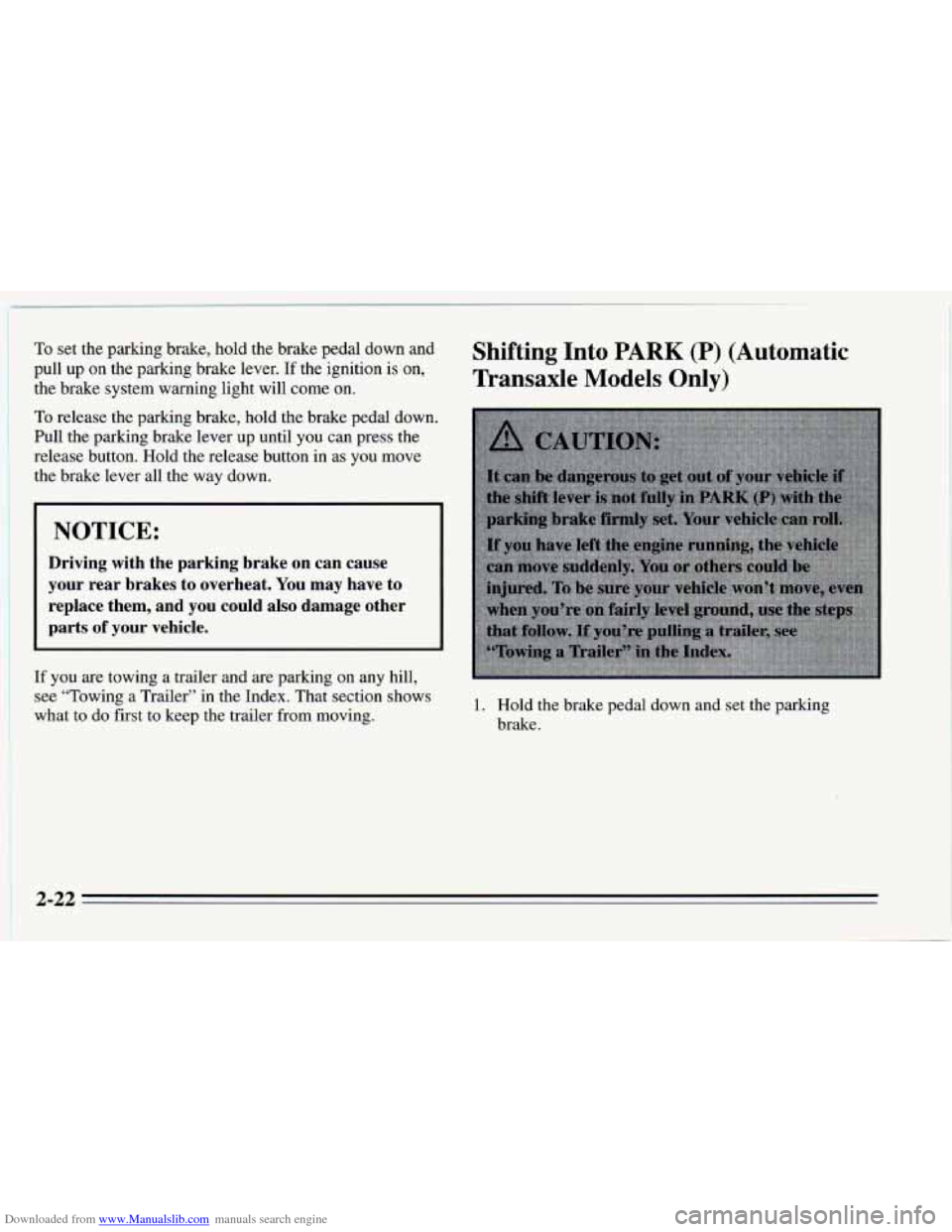
Downloaded from www.Manualslib.com manuals search engine To set the parking brake, hold the brake pedal down and
pull up on the parking brake lever. If the ignition
is on,
the brake system warning light will come on.
To release the parking brake, hold the brake pedal down.
Pull the parking brake lever up until you can press the
release button.
Hold the release button in as you move
the brake lever all the way down.
I NOTICE:
Driving with the parking brake on can cause
your rear brakes to overheat. You may have to
replace them, and you could also damage other
parts
of your vehicle.
If you are towing a trailer and are parking on any hill,
see “Towing a Trailer’’ in the Index. That section shows
what to
do first to keep the trailer from moving.
Shifting Pnto PARK (P) (Automatic
Transaxle Models Only)
1. Hold the brake pedal down and set the parking
brake.
2-22
Page 92 of 340
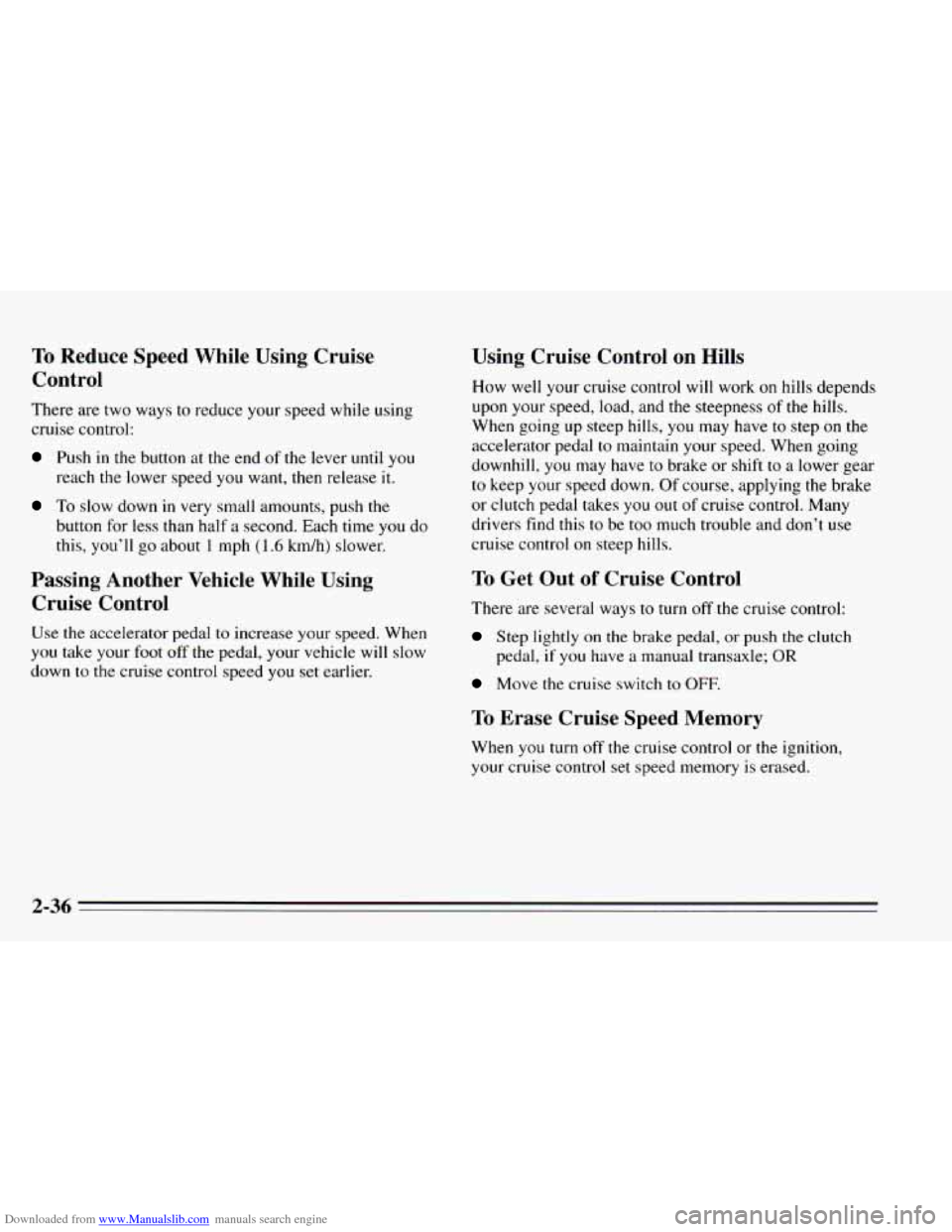
Downloaded from www.Manualslib.com manuals search engine To Reduce Speed While Using Cruise
Control
There are two ways to reduce your speed while using
cruise control:
Push in the button at the end of the lever until you
reach the lower speed
you want, then release it.
To slow down in very small amounts, push the
button for less than half a second. Each time you do
this, you’ll
go about 1 mph (1.6 kmh) slower.
Passing Another Vehicle While Using Cruise Control
Use the accelerator pedal to increase your speed. When
you take your foot off the pedal, your vehicle will slow
down to
the cruise control speed you set earlier.
Using Cruise Control on Hills
How well your cruise control will work on hills depends
upon your speed, load, and
the steepness of the hills.
When going up steep hills,
you may have to step on the
accelerator pedal
to maintain your speed. When going
downhill, you may have to brake or shift to a lower gear
to keep your speed down. Of course, applying the brake
or clutch pedal takes
you out of cruise control. Many
drivers find this
to be too much trouble and don’t use
cruise control on steep hills.
To Get Out of Cruise Control
There are several ways to turn off the cruise control:
Step lightly on the brake pedal, or push the clutch
pedal, if you have
a manual transaxle; OR
Move the cruise switch to OFF.
To Erase Cruise Speed Memory
When you turn off the cruise control or the ignition,
your cruise control
set speed memory is erased.
2-36
Page 94 of 340

Downloaded from www.Manualslib.com manuals search engine Instrument Panel Intensity Control Daynme Running Lamps (Canada Only)
You can brighten or dim the instrument panel lamps by
turning the dial up
or down.
Turn the dial up all the way
to turn on the interior
courtesy lamps. Daytime Running Lamps (DRL) can make
it easier for
others
to see the front of your vehicle during the day.
DRL can be helpful
in many different driving
conditions, but they can be especially helpful in the
short periods after dawn and before sunset. Several
countries, including Canada, require DRL.
The DRL system will make your high beam headlamps
come
on at a reduced brightness in daylight when:
0 The ignition is on,
0 The headlamp switch is off,
0 The parking brake is released and
On vehicles with automatic transaxles the shift lever
is moved from PARK
(P).
2-38
~~ -.
Page 95 of 340
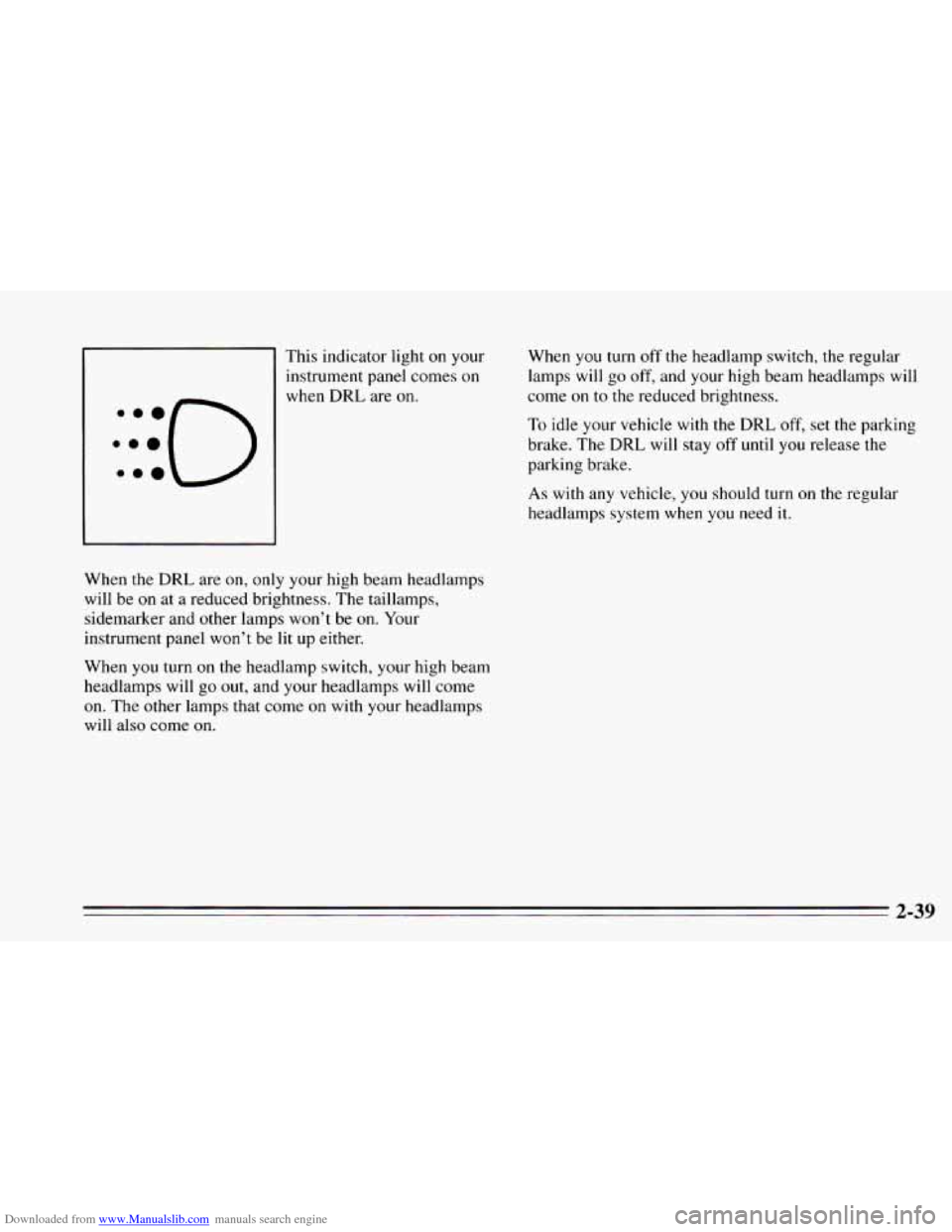
Downloaded from www.Manualslib.com manuals search engine This indicator light on your
instrument panel comes
on
when DRL are on. When
you turn
off the headlamp switch, the regular
lamps will
go off, and your high beam headlamps will
come on
to the reduced brightness.
To idle your vehicle with the DRL off, set the parking
brake. The
DRL will stay off until you release the
parking brake.
As with any vehicle, you should turn on the regular
headlamps system when you need it.
When the
DRL are on, only your high beam headlamps
will be on at a reduced brightness. The taillamps,
sidemarker and other lamps won’t be
on. Your
instrument panel won’t be lit up either.
When
you turn on the headlamp switch, your high beam
headlamps will go out, and your headlamps will come
on. The other lamps that come
on with your headlamps
will also come
on.
Page 118 of 340
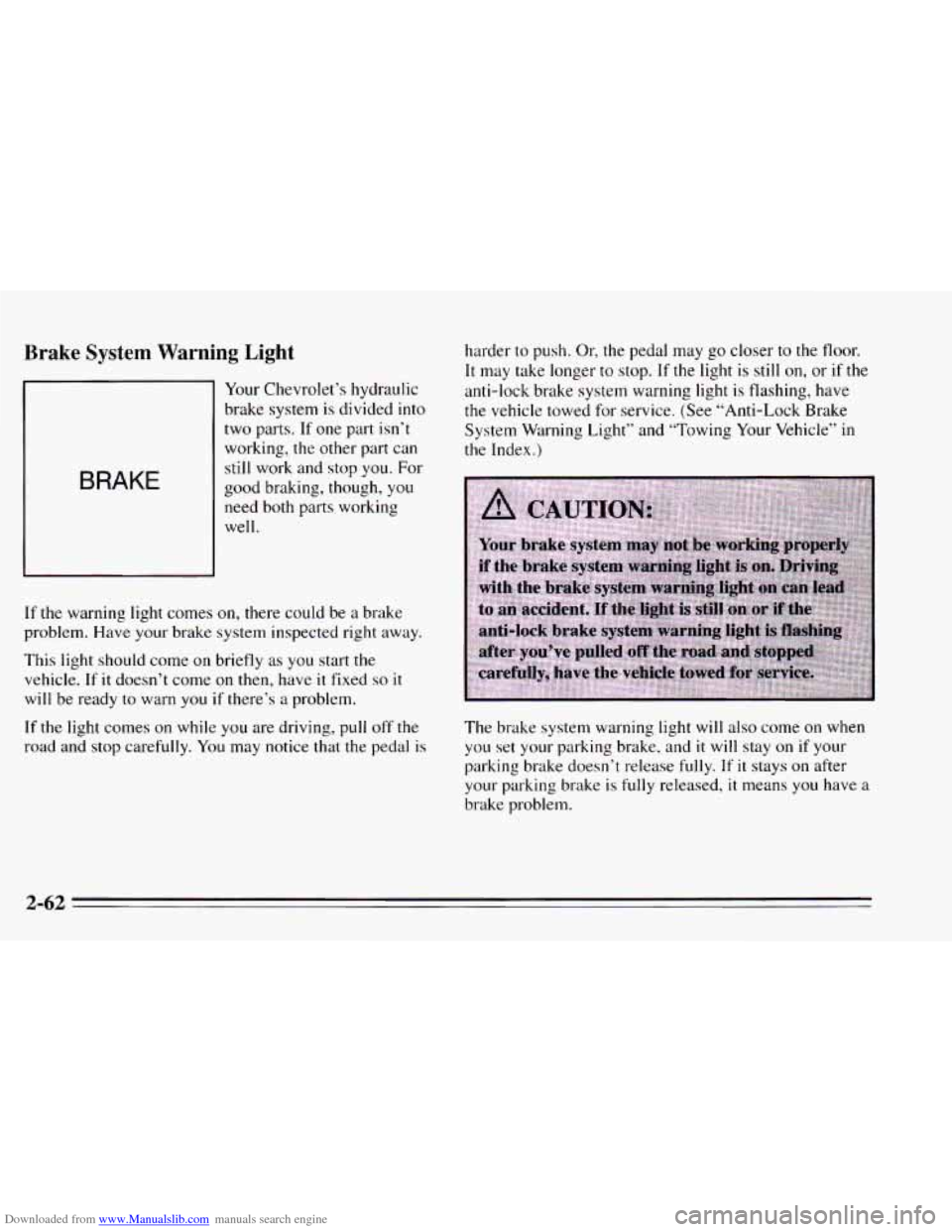
Downloaded from www.Manualslib.com manuals search engine Brake System Warning Light
BRAKE
Your Chevrolet’s hydraulic
brake system is divided
into
two parts. If one part isn’t
working, the other part can
still work and stop you. For
good braking, though, you
need both parts working
well.
If the warning light comes on, there could be a brake
problem. Have your brake system inspected right away.
This light should come on briefly as you start the
vehicle. If it doesn’t come on then, have it fixed so it
will be ready to warn you if there’s a problem.
If the light comes on while you are driving, pull off the
road and stop carefully.
You may notice that the pedal is
harder to push. Or, the pedal may go closer to the floor.
It may take longer to stop. If the light is still on, or if the
anti-lock brake system warning light is flashing, have
the vehicle towed for service. (See “Anti-Lock Brake
System Warning Light” and “Towing Your Vehicle”
in
the Index.)
The brake system warning light will
also come on when
you set your parking brake, and
it will stay on if your
parking brake doesn’t release
fully. If it stays on after
your parking brake
is fully released, it means you have a
brake problem.
2-62
Page 119 of 340
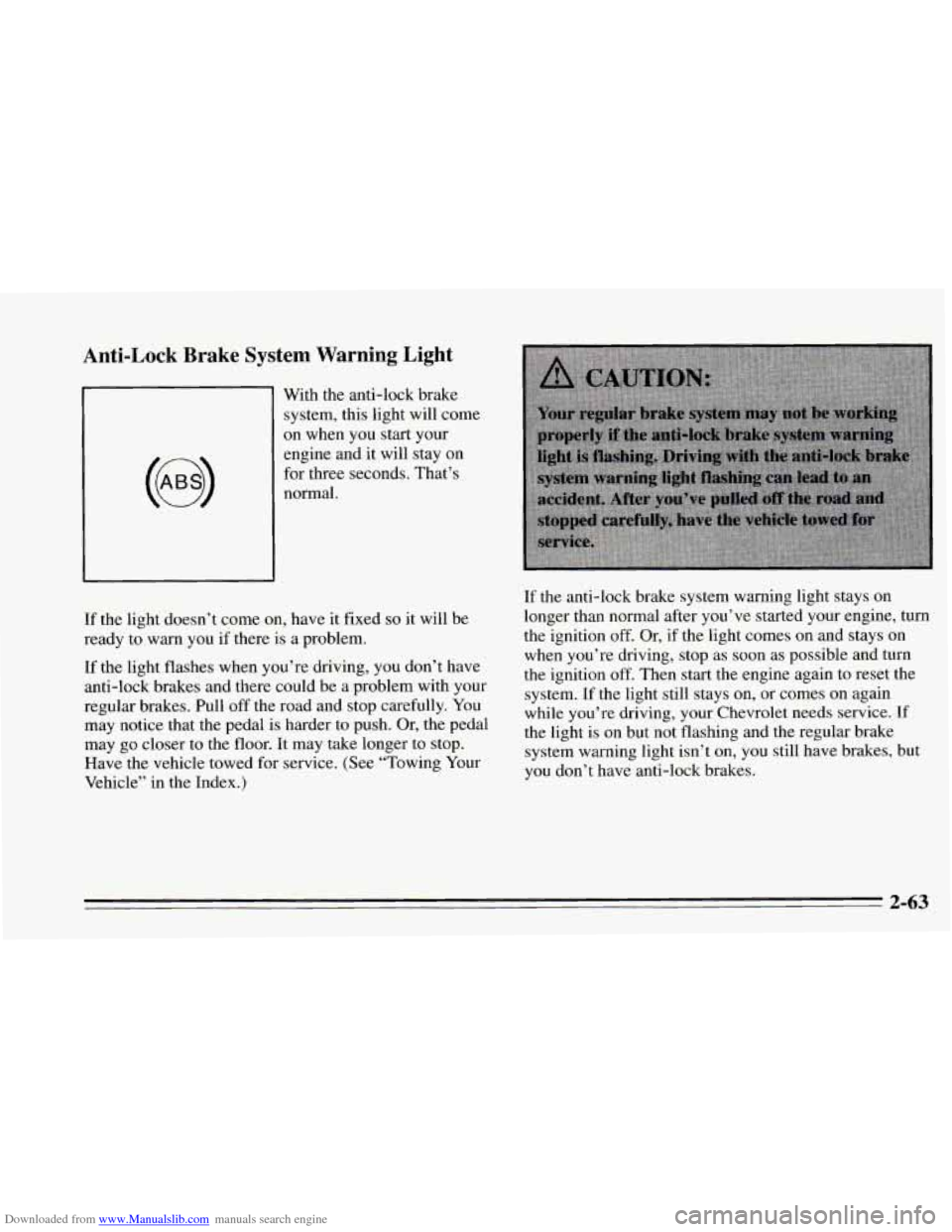
Downloaded from www.Manualslib.com manuals search engine Anti-Lock Brake System Warning Light
1 With the anti-lock brake
’ system, this light will come
on when you start your
engine and it will stay on
for three seconds. That’s
normal.
If the light doesn’t come on, have it fixed
so it will be
ready to warn you if there is a problem.
If the light flashes when you’re driving,
you don’t have
anti-lock brakes and there could be a problem with your
regular brakes. Pull off the road and stop carefully. You
may notice that the pedal is harder to push. Or, the pedal
may
go closer to the floor. It may take longer to stop.
Have the vehicle towed for service. (See “Towing Your
Vehicle” in the Index.) If
the anti-lock brake system warning light stays on
longer than normal after you’ve started your engine, turn
the ignition off. Or, if the light comes on and stays on
when you’re driving, stop as soon as possible and turn
the ignition
off. Then start the engine again to reset the
system. If the light still stays on, or comes
on again
while you’re driving, your Chevrolet needs service.
If
the light is on but not flashing and the regular brake
system warning light isn’t on,
you still have brakes, but
you don’t have anti-lock brakes.
2-63